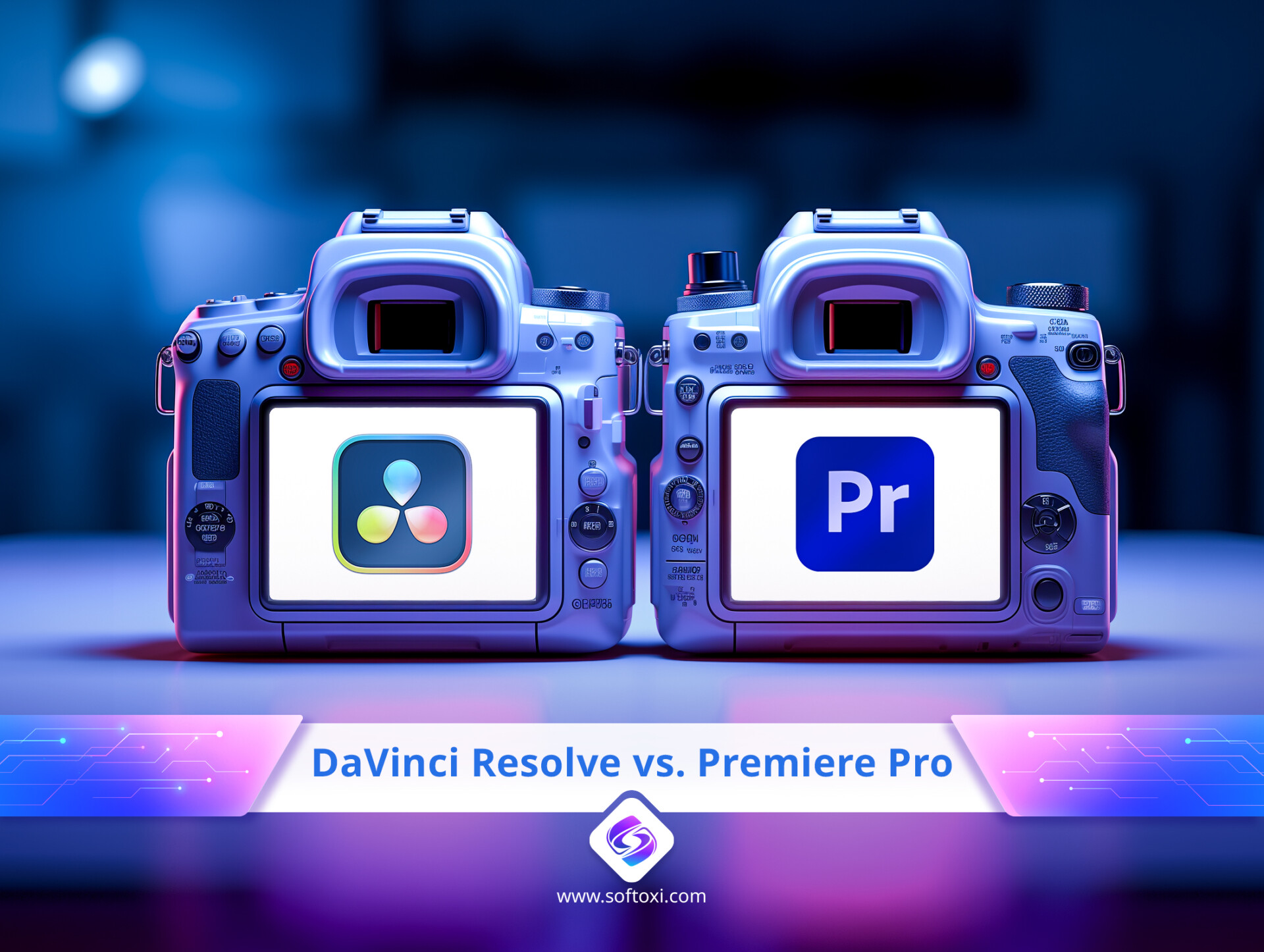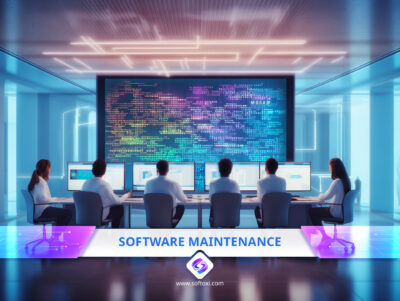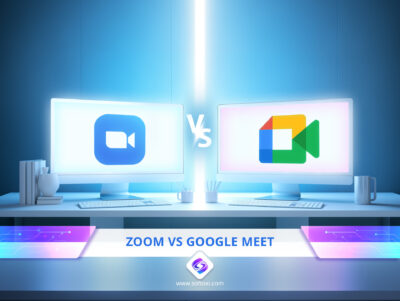The video editing market is booming as more people turn to videos for content. The last few years have seen many new and established players enter this space. Out of these many players, Adobe Premiere Pro and DaVinci Resolve have emerged as the top players because of their extensive capabilities.
As a video editor, choosing the right tool can make a big difference to your work. This article compares DaVinci Resolve vs. Premiere Pro across many features to help you make the right pick.
Exploring DaVinci Resolve
DaVinci Resolve is a comprehensive video editing software that combines editing, color correction, visual effects, and motion graphics. It’s a popular choice today for the post-production of audio, videos, and even movies.
Developed by Blackmagic Design, this tool works well on macOS, Windows, and Linux. It even offers a free version that includes all the features most amateurs and professionals need for video editing.
Key Features and Capabilities
Some key features and capabilities of DaVinci Resolve are:
- With its drag-and-drop interface, you can add any video, image, or footage for editing. It works well with all professional audio and video formats.
- You can mark the clips using in and out points for easy editing.
- There are seven ways to edit your clips: insert, overwrite, replace, fit to fill, place on top, append at the end, and ripple overwrite.
- The smart trimming tool saves time and effort while providing precise trims.
- The cut page speeds up the editing process. However, you can also choose the traditional page if that suits you better.
- It offers dual timelines, where the upper timeline shows the entire program while the lower timeline shows a zoomed area.
- Resolve’s advanced color corrector balances image color to create stunning images and videos.
- You can add cinematic visual effects and motion graphics on the Fusion page.
- It has an exclusive audio post-production capability called Fairlight.
- DaVinci Resolve offers a cloud collaboration feature called Blackmagic Cloud to allow people from different countries to collaborate on a project.
- It has well-designed keyboards, panels, and consoles for easy editing.
All these features make the DaVinci Resolve a top video editing tool today.
To know more, read our “Comprehensive Guide to DaVinci Resolve.”
DaVinci Resolve’s Versions: Free vs. Studio
The Free version of DaVinci Resolve has more features than the paid versions of many video editing apps. However, if you need advanced features or specific capabilities, buy the Studio edition.
Here’s a quick look at the differences between the Free and Studio editions.
| Features | Free Edition | Studio Edition |
|---|---|---|
| Frame rate | 60 fps | 120 fps |
| Max resolution | Up to 4K | 8K |
| No. of GPUs | One | Multiple |
| Noise reduction | Manual or need a plugin | Sophisticated built-in tools |
| Lens correction | No | Yes |
| Neural engine with advanced AI and ML-based automation. | No | Yes |
| Formats | 8-bit | 8-bit and 10-bit |
| High-res 3D audio editing | No | Yes |
| HDR scopes | No | Yes |
Overall, the Free version includes color grading and visual effects capabilities. However, the Studio edition is comprehensive and has everything you need for editing all video formats.
The Studio is also reasonably priced at a flat rate of $295. Plus, this edition comes with a lifetime of updates.
Understanding Premiere Pro
Adobe Premiere Pro is a professional video editing platform for creating and editing videos for the web, TV shows, and even films. Developed by Adobe, this tool is well-suited for amateurs and professional video editors.
Some key features of Adobe Premiere Pro are:
- Premiere Pro comes with beautiful templates for videos.
- Its AI tools speed up transcription, editing, color, audio, and captioning capabilities.
- You can create rough cuts quickly with its test-based editing.
- Its three-point editing and stacked timelines ease the editing process.
- The trim tools support rippling, sliding, rolling, and sliding edits.
- It has hundreds of built-in video effects and transitions.
- Premiere Pro automatically balances colors with AI.
- You can reduce noise and enhance dialogs with professional audio editing tools.
- It supports collaboration through Frame.io
Due to these features, Adobe Premiere Pro holds a top position in the video editing industry today.
Adobe Premiere Pro’s Position in the Industry
Adobe Premiere Pro has about 22,000 customers, with a market share of 20.73%. Most of its customers are into marketing, social media, and digital marketing, reflecting the use of Premiere Pro for creating marketing materials.
Out of its customers, more than 4,600 companies have an employee size of 20 to 49, and about 4,000 customers have only 0 to 9 employees. This trend reflects the suitability of Premiere Pro for small and medium-sized organizations.
One of the reasons for this wide adoption of Premiere Pro is its integration with other products in the Adobe ecosystem to give users a one-stop place for everything they need.
Compatibility and Integration Within Adobe Ecosystem
The Adobe Premiere Pro seamlessly integrates with other tools in the Adobe ecosystem to create the desired workflows. You can leverage Adobe’s APIs and plugins to support new file formats, build effects and transitions, manage metadata, and more.
With Mercury Transmit, you can send the videos edited on Adobe Premiere Pro to any external device or connection. Similarly, you can use the control surface API to sync with external hardware like faders and VU meters.
Furthermore, Premiere Pro is compatible with Frame.io to support collaboration with editors and producers. Also, it integrates with Pond5 to test and buy music clips and FilmImpact for transitions and videos.
Such integrations make Adobe Premiere Pro a comprehensive choice for video editors.
“Mastering Adobe Premiere Pro: Tips and Tricks”
Key Differences Between DaVinci Resolve and Premiere Pro
DaVinci Resolve and Premiere Pro are non-linear editing tools, which means you can add and rearrange any clips in any order. You can also add color upgrades, music, visual graphics, and motion transitions for extra effects and to make your end video appealing to your target audience.
At first glance, both tools may seem similar, but an in-depth comparison will show their differences. Let’s see how Adobe vs DaVinci stack up on the video editing aspects.
Comparative Analysis of Video Editing Features
DaVinci Resolve started as a color grading and correction tool before enhancing its capabilities to become a video editing tool like Premiere Pro.
A key difference in their video editing features lies in their approach. Premiere Pro offers a layering approach, where you can add a new effect or transition as a separate layer. When you want to experiment with a different transition or remove something, simply hide or remove the layer containing it.
On the other hand, Resolve uses a node-based system. A node represents a specific action like a color correction or visual effect. You can connect more than one node as a flowchart to create a complex visual structure for effects and edits.
Out of the two, nodes can take a little longer to learn since layering is present across many editing tools. Also, given the Premiere Pro has been around longer, you could feel more comfortable with layers. However, Resolve’s node-based approach offers exceptional control over the editing process, though it could take some time to learn.
Software Suite Components: All-in-One Solutions
A key advantage of Premiere Pro is its ability to link with other apps in the Adobe ecosystem. With many products in the Creative Cloud, like Photoshop, Illustrator, and After Effects, this integration can help with advanced video production with complex workflows.
Blackmagic Design, on the other hand, does not have other products. However, DaVinci Resolve is comprehensive in every sense. Its Cut and Edit tabs help to import videos and attach them creatively. The Fusion functionality is similar to After Effects, and Fairlight is akin to Adobe Audition.
In this sense, both tools are comprehensive solutions. While Premiere Pro integrates with other tools in the Adobe ecosystem, DaVinci Resolve is a standalone platform that has the features of Adobe’s multiple tools.
Pricing and Value
Adobe Premiere Pro follows a monthly subscription model and costs $20.99 monthly. Access to all the tools in Adobe Creative Cloud is $52.99 per month for individuals, students, and teachers. For businesses, this integrated offering costs $79.99.
Adobe Premiere Pro has no free plan.
DaVinci Resolve has a free plan that’s sufficient for amateurs. Its Studio plan costs a one-time payment of $295. With this license, you get free updates as they become available.
DaVinci vs. Premiere Pro – which is a better value for money?
DaVinci Resolve is the best value for money, as you get all the features for a one-time payment of just $295. Plus, you don’t have to plan for monthly payments and renewals.
Next, let’s move to the all-important aspect of performance.
Performance and Compatibility
DaVinci Resolve is a solid platform with exceptional performance. The playback is smooth, and the import times are quick and error-free. However, the downside is that Resolve requires more system resources. Blackmagic Design recommends a minimum of 16 GB to run this tool.
Premiere Pro, on the other hand, lags. Users have reported many crashes and bugs. Also, Premiere Pro is slower to load high-definition videos when compared to Resolve.
As for resource utilization, Premiere Pro can run well on 8 GB RAM and takes up fewer resources than Resolve.
When it comes to stabilization, Resolve scores hands down over Premiere Pro. Though there’s a specialized Warp Stabilizer Tool in Adobe, it is nowhere close to the stabilization levels offered by Resolve.
System Compatibility and User Experience
Moving on to compatibility, you can run Resolve on Linux, Windows, and Mac, while Premiere Pro works only on Windows and Mac.
Another compatibility difference is the Blackmagic RAW format, which runs in Resolve but is unsupported in Premiere Pro. Otherwise, both platforms support all popular file formats.
User Interface and Usability
When it comes to usability, Premiere Pro scores over DaVinci Resolve.
Like the other products in Adobe Suite, Premiere Pro is for all user levels. On the other hand, DaVinci Resolve is not beginner-friendly. You need a certain level of experience and expertise to use this tool.
This difference in usability also stems from the variations in the user interface’s structure.
Interface Comparison
Premiere Pro uses the Non-Linear Editing (NLE) Timeline interface. It consists of audio, video, pictures, or other media sequences. You can edit and rearrange these elements in any order, and Premiere Pro automatically saves your workspace. This simple organization is intuitive and saves time.
DaVinci Resolve takes a different approach to the user interface. It uses a Freeform Timeline editor that divides the user interface into five sections: Edit, Cut, Color, Fusion, and Fairlight. Each section functions as the name suggests. The Fusion section is for adding motion graphics, while Fairlight is the audio editing tool.
When you compare Premiere Pro vs DaVinci Resolve, Pro is easier to use. You can quickly complete tasks like masking and keyframing. But these actions could require some extra effort in Resolve.
Learning Curve Analysis
The learning curve is steeper in DaVinci Resolve than in Premiere Pro. One reason is that Premiere Pro has been around longer and uses techniques like sequences and layering – aspects that every professional video editor who has used any tool is familiar with.
Since Resolve uses nodes and a freeform interface, it can be intimidating for beginners. Even for experienced editors, this can take some time to learn and adapt. Once mastered, though, the level of control and flexibility that Resolve offers is unmatched.
Community and Support
DaVinci Resolve and Premiere Pro have strong communities but differ in the nature of their support.
Since Premiere Pro has been in the market longer, they have an extensive online community. You can join one of the social media groups to get answers to almost any doubt or question you have. Also, some highly experienced editors can make appropriate suggestions for any situation.
DaVinci Resolve, on the other hand, is a growing tool with limited community support. Most groups also focus more on color grading and post-production features than general editing.
Learning Resources and Community Support
Adobe.com has extensive tutorials providing a detailed walkthrough of each feature and the steps to use it.
Also, Resolve offers many training videos to introduce you to the tool and its specific features.
When you compare the two, Premiere Pro’s learning resources are far more extensive than Resolve. Also, the vibrant and large community can answer your questions.
Customer Service and Updates
Adobe’s customer support is excellent, and Blackmagic is yet to catch up.
As for updates, they are automatic when you buy the Studio version. All you have to do is update the tool, and the rest will work seamlessly. The update process in Adobe is a bit longer as you have to manually navigate to Apps > Update on Creative Cloud.
Now that we’ve seen how DaVinci vs. Premiere stack against each other, let’s move on to the use cases.
Industry Use Cases
DaVinci Resolve’s sophisticated features make it better suited for post-production video and audio editing, while Premiere Pro works well for creating and editing marketing content. Also, Resolve’s steep learning curve and high system requirements are ideal for professional video editors. Premiere Pro is a good choice for beginners, amateurs, and professionals.
Typical User Profiles and Industry Preferences
The choice depends on user preferences, video editing goals, and expertise.
Resolve is comprehensive and has all the features you need for video editing on a single platform. Also, the free plan is sufficient, while the Studio edition is budget-friendly. Although you can collaborate with Resolve, you’ll have to pay for the Blackmagic Cloud, where you’ll move your files and workspaces for collaboration.
On the other hand, Adobe Premiere Pro is well-suited for organizations that have to create regular videos. Since it’s a part of Adobe Creative Cloud, creators can easily share files and collaborate in an organization. It is also a good choice for small studios and production houses that can’t spend on extensive hardware.
Case Studies and Professional Applications
Many companies are using Premiere Pro to create video projects. For example, Hershey has created 3D scenes of its store displays, while Rock Paper Reality created 3D experiences. A common aspect of all projects is the speed of creation. Warriors delivered a clip to Twitter in three minutes, and the Voice of the Oceans took 25% less time to create video content.
DaVinci Resolve’s use cases revolve around TV shows and movies. The short series titled “From DC, I Love You” was edited with Resolve. Also, more than 30 films released in the summer of 2022 were edited with Resolve.
In all, both tools have extensive video editing capabilities. However, some variations make each tool ideal for a certain user group.
DaVinci Resolve vs. Premiere Pro – The Battle of the Giants
The DaVinci Resolve vs. Premiere Pro comparison shows that each tool has distinct features that cater to different needs within the video editing industry.
DaVinci Resolve stands out for its advanced color correction, motion graphics, and unique node-based editing system. The free version is robust, while the Studio edition offers expanded capabilities at a one-time cost of $295. However, the learning curve for Resolve is steeper, and its community support is still evolving.
On the other hand, Adobe Premiere Pro seamlessly integrates with the Adobe ecosystem. Its user-friendly interface, extensive library of effects, and collaboration capabilities make it a popular choice, especially among small to medium-sized organizations. However, its subscription-based pricing model, starting at $20.99 per month, can get expensive.
Summary of Comparative Analysis
Below is a quick summary of the comparison:
| Feature | Winner | Reason |
|---|---|---|
| Usability | Premiere Pro | Uses familiar techniques like sequencing and layering. |
| Value for money | DaVinci Resolve | The free plan is comprehensive, and the Studio is available for a one-time fee of $295. |
| Community and support | Premiere Pro | Has excellent support and an expansive community. |
| Collaboration | Premiere Pro | Due to its integration with Adobe Creative Cloud |
| Advanced capabilities | DaVinci Resolve | Its hardware and software are ideal for editing movies and TV shows. |
| Performance and stabilization | DaVinci Resolve | Premiere Pro has many reported crashes and bugs. |
| Learning curve | Premiere Pro | Simpler to learn. |
| System compatibility | DaVinci Resolve | It works on Linux. |
| Hardware investment | Premiere Pro | It requires fewer resources to run. |
Final Recommendations
DaVinci Resolve vs Premiere Pro – which should you choose?
The answer depends on your preferences, project requirements, and proficiency levels.
DaVinci Resolve is an excellent choice if you:
- Are into advanced post-production.
- Need extensive features like color correction, intricate visual effects, and a well-developed audio editing tool.
- Prefer a one-time payment model.
- Are an expert in video production and don’t mind the learning curve
Go for Adobe Premiere Pro if you:
- Already use the Adobe ecosystem.
- Require extensive collaboration.
- Consider customer and community support important.
- Prefer a simple user interface and familiar editing techniques.




